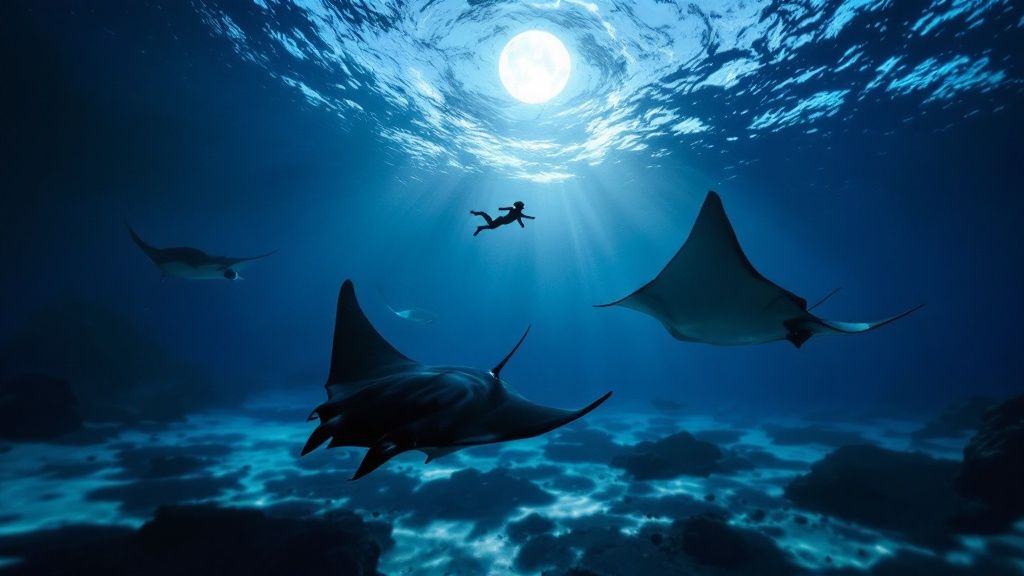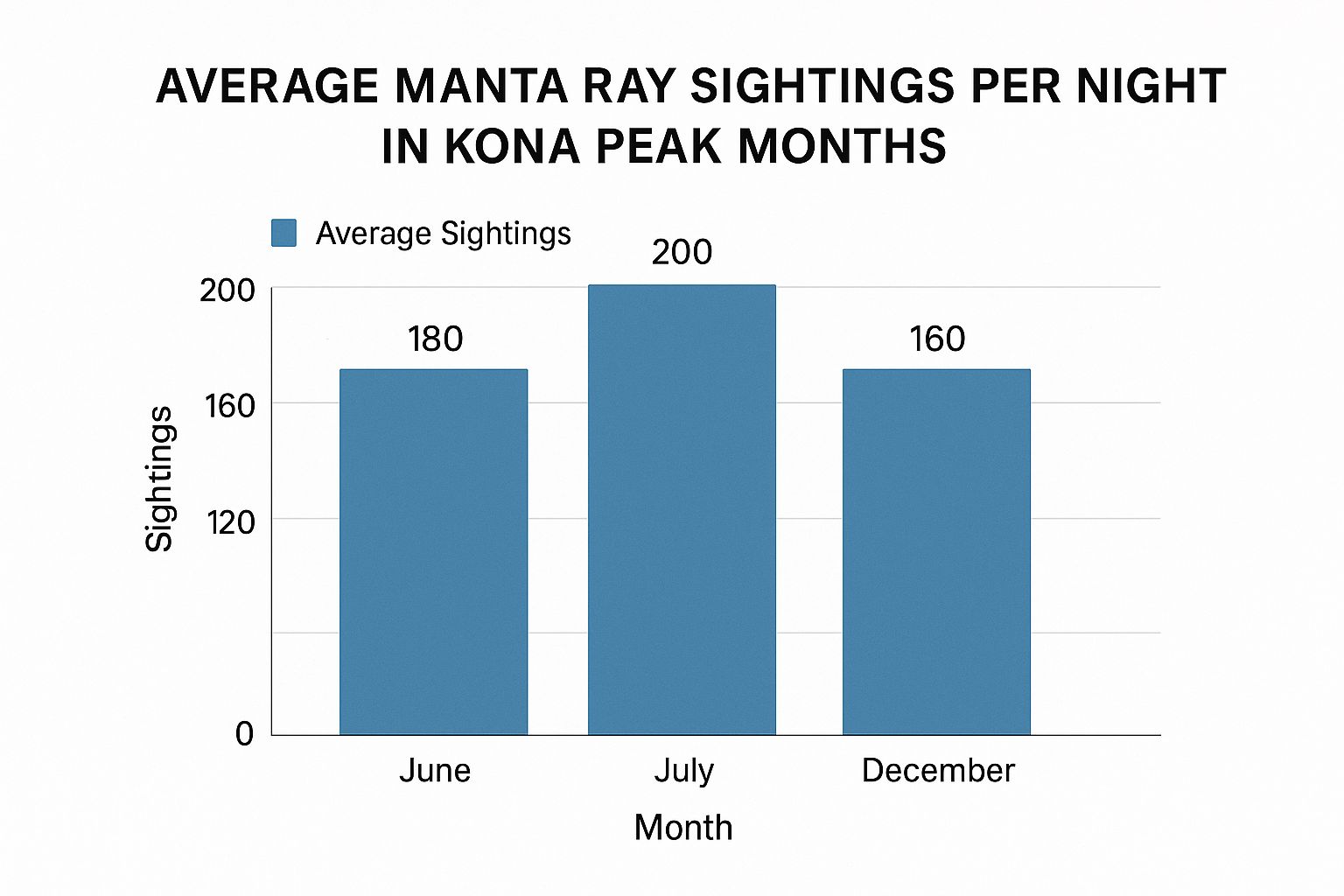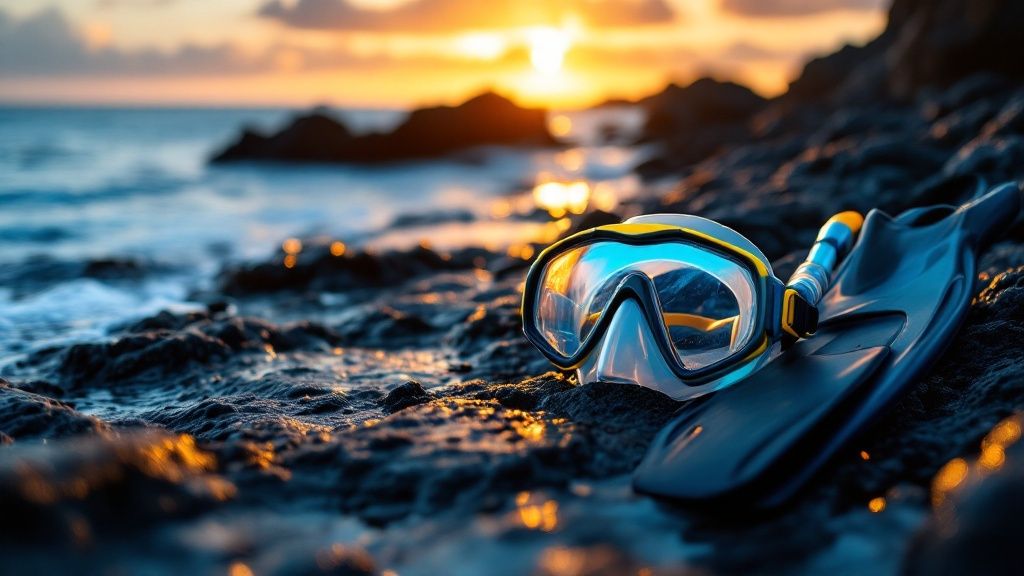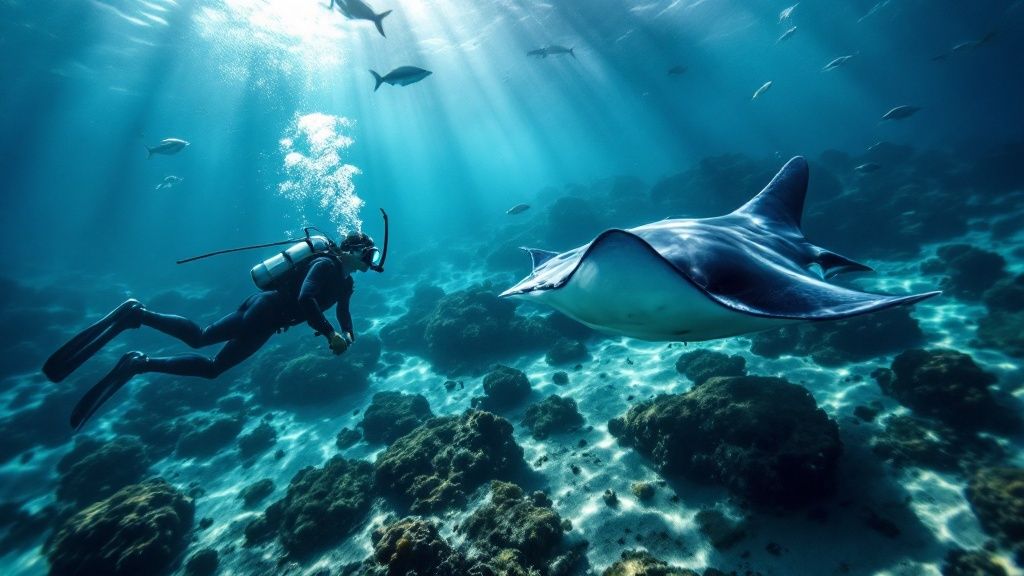Manta Ray Snorkel Kona | Experience Hawaii’s Greatest Adventure
- Byron
- Apr 29
- 11 min read
Why Kona's Manta Ray Experience Stands Alone

Manta rays, with wingspans sometimes reaching 16 feet, are deeply embedded in Hawaiian culture. From ancient legends depicting them as guardians to modern conservation efforts, these creatures are highly respected. This reverence, combined with Kona's unique environment, creates an exceptional manta ray snorkel experience.
A Perfect Harmony of Nature and Conservation
Kona's protected bays offer a special ecological haven. Ancient feeding patterns and modern conservation intersect here, supporting a flourishing manta ray population. The area's volcanic geography creates underwater landscapes that serve as ideal feeding grounds. This unique combination transforms visitors into ocean advocates.
Tour operators use artificial light systems that mimic the moon's reflection, attracting plankton. This, in turn, draws the manta rays to the surface for a reliable feeding opportunity. Kona's manta ray snorkel tours have an 80-90% sighting success rate year-round, based on 2025 data from local operators like Jack's Diving Locker and Kona Snorkel Trips. While seasonal variations exist, with summer months sometimes bringing larger groups, this consistency sets Kona apart from other manta habitats. For more detailed statistics, see the Jack's Diving Locker Manta Ray Report.
The Magic of a Moonlit Ballet
Imagine floating in the cool, dark water as these gentle giants dance below. Their movements, a mesmerizing ballet illuminated by moonlight and specialized dive lights, create an unforgettable experience. This is the magic of a Kona manta ray snorkel adventure. It's a profound connection with nature.
This close encounter is also educational. Experienced guides share insights into manta ray biology and behavior, enriching the observation. You can learn more through resources like Manta Ray Night Snorkel Blog Posts. Many operators prioritize sustainable practices, minimizing disruption to the mantas and their habitat. This commitment to conservation makes the Kona manta ray experience unique, putting the well-being of these creatures first.
The Hidden Gems: Kona's Premier Manta Viewing Spots
Kona, Hawaii, is renowned for its incredible manta ray encounters. This isn't a coincidence. Ancient volcanic activity shaped the underwater landscape, creating ideal feeding grounds for these gentle giants. The island's dedication to manta ray conservation further enhances these natural havens. Protected bays, teeming with plankton, provide the perfect setting for manta ray snorkel Kona experiences.
Manta Village and Manta Heaven: Kona's Star Attractions
Two spots are particularly famous: Manta Village (Keauhou Bay) and Manta Heaven (Garden Eel Cove). Manta Village, nestled in Keauhou Bay, has been a research hub for decades. Scientists have identified and even named many of the resident mantas here. This ongoing research provides valuable insights into these captivating creatures. Manta Heaven, located in Garden Eel Cove, is known for its crystal-clear waters and frequent sightings of multiple mantas, truly earning its name.
The Impact of Underwater Topography
The unique underwater terrain at each site influences manta ray behavior and, therefore, the quality of viewing experiences. Experienced boat captains understand these subtleties and choose locations strategically based on ocean conditions. Even slight changes in location can significantly impact your experience. For instance, certain underwater formations create currents that concentrate plankton, attracting larger groups of mantas.
To illustrate the varying viewing experiences throughout the year, let's take a look at the data from 2013. The following data chart visualizes the average number of manta rays sighted per month at Manta Village and Manta Heaven:

As the data chart shows, manta ray sightings remain consistent year-round, with a notable increase in December. This confirms Kona's status as a prime manta ray destination throughout the year.
To further explore the differences between these prime viewing locations, the table below provides a detailed comparison:
Comparison of Top Manta Ray Snorkel Sites in Kona Comparing the most popular manta ray snorkel locations in Kona based on key factors that affect visitor experience
Site Name | Average # of Mantas | Best Months | Water Conditions | Accessibility | Special Features |
|---|---|---|---|---|---|
Manta Village (Keauhou Bay) | 7-8 (based on 2013 data) | Year-round, peak in December | Typically calm | Easy access from shore | Long-term research site, many identified mantas |
Manta Heaven (Garden Eel Cove) | 7-8 (based on 2013 data) | Year-round, peak in December | Excellent visibility | Boat access required | Frequent sightings of multiple mantas |
As you can see, both locations offer excellent viewing opportunities throughout the year, though they differ in accessibility.
The 2013 annual report from Manta Village and Manta Heaven documented 2,856 individual manta ray sightings over 365 nights, averaging 7.8 mantas per night. December saw a peak of 11 mantas observed at once, while April had the most consistent sightings. This meticulous data collection, through daily video and ID verification by marine biologists, sets a high standard for manta ecotourism.
Beyond the Famous Spots: Hidden Gems and Local Knowledge
While Manta Village and Manta Heaven are deservedly popular, experienced operators know other exceptional spots. These alternative locations are often chosen based on specific ocean conditions, ensuring the best possible viewing regardless of the daily forecast. This local expertise highlights the importance of selecting a seasoned tour operator for your manta ray snorkel Kona adventure. You can explore further resources on our sitemap. This intimate knowledge of the waters combined with the consistent presence of mantas promises an unforgettable experience.
Selecting Your Perfect Manta Ray Experience Provider
Choosing the right manta ray snorkel tour operator in Kona can significantly impact your trip. Price is definitely a factor, but it shouldn't be the only one. Think about things like the guides' marine biology expertise, the size of the group, and the operator's commitment to manta ray conservation. Finding a provider who prioritizes these elements can turn a simple snorkel trip into a truly educational and memorable adventure.
Why Group Size Matters
The number of people in your group can drastically change your manta ray encounter. Smaller groups mean more personalized attention from the guides. They can share fascinating insights into manta ray behavior and answer all your questions. It also creates a more intimate, less intrusive experience, minimizing disturbance to the mantas and maximizing your chances for up-close, breathtaking views. Larger groups, on the other hand, can feel crowded and chaotic. This can stress the mantas and obscure your view.
What Sets Exceptional Operators Apart?
A few key factors distinguish truly exceptional manta ray tour operators. Seek out operators with certified marine biologists on staff or those who partner with researchers. This specialized knowledge adds another layer to the tour, offering deeper insights into manta ray biology, behavior, and the importance of conservation. When choosing your manta ray experience provider, consider operators who also offer other snorkeling opportunities, such as trips focused on Marathon Key snorkeling. Also, consider the operator’s commitment to sustainable practices and manta ray welfare. Do they adhere to responsible viewing guidelines? Do they actively support conservation initiatives? Choosing an eco-conscious operator ensures your experience contributes to the long-term well-being of these gentle giants.
Questions to Ask Potential Operators
Before you book, asking a few key questions can help you evaluate an operator’s approach and values. Inquire about their group size limits, the guides’ experience levels, and their conservation efforts. It's also wise to ask about their cancellation policy regarding weather conditions or manta ray sightings. Don't hesitate to ask for references or read online reviews from past participants. Doing your homework will help you find an operator that aligns with your priorities and sets the stage for a truly rewarding adventure. For more tips, check out this resource on planning your Kona trip.
Insider Booking Strategies
Seasoned travelers often use a few smart strategies to secure the best manta ray snorkel tours. Booking in advance, especially during peak season, is essential to guarantee availability. Consider scheduling your manta ray adventure early in your trip. This provides flexibility for rescheduling in case of unexpected cancellations. Look into options for photography packages or private charters for a more tailored experience. Finally, let your chosen operator know about any special needs or concerns you have, such as seasickness or limited swimming ability, so they can make necessary accommodations.
To help you compare different tour operators, we've put together a handy guide:
Manta Ray Tour Operator Comparison Guide
Detailed comparison of top-rated manta ray snorkel tour operators in Kona with prices, inclusions, and customer ratings
Tour Operator | Group Size | Duration | Price Range | Inclusions | Conservation Efforts | Customer Rating |
|---|---|---|---|---|---|---|
Example Operator A | 6-8 | 2 hours | $150-$180 | Snorkel gear, wetsuit, light refreshments | Supports local manta ray research | 4.8/5 |
Example Operator B | 10-12 | 2.5 hours | $120-$150 | Snorkel gear, wetsuit | Participates in reef cleanup initiatives | 4.5/5 |
Example Operator C | 4-6 | 3 hours | $180-$220 | Snorkel gear, wetsuit, underwater photography, dinner | Donates a portion of proceeds to manta ray conservation | 4.9/5 |
This table provides example data and should be replaced with actual tour operator information.
As you can see, different operators offer various group sizes, durations, and inclusions. Choosing the right one depends on your priorities and budget. Consider what's most important to you – a smaller, more intimate group, longer duration, included extras, or a strong focus on conservation.
The Night Unfolds: Your Manta Ray Adventure Journey
Your manta ray snorkel Kona adventure begins well before you enter the water. The excitement builds as you leave the harbor, often as the sun dips below the horizon, painting the Kona sky with vibrant colors. This stunning prelude sets the scene for the magical encounter that awaits.
Setting the Stage for an Underwater Spectacle
As darkness descends, the crew prepares the underwater lights. These specialized lights, designed to attract plankton, are essential for the experience. They create a localized plankton bloom, which draws the manta rays closer to the surface, giving you an unparalleled view of their feeding ritual. This carefully orchestrated setup makes Kona a world-renowned destination for this unique activity and increases the likelihood of manta ray sightings.
The Mantas Arrive: A Dance of Grace and Power
The moment the mantas arrive is truly electrifying. Their initial approach is often slow and graceful. As they get closer, their feeding behavior becomes more pronounced. They perform captivating barrel rolls and backflips, their large mouths wide open, filtering the plankton-rich water. It's a stunning display of power and elegance, a remarkable spectacle of nature. Between 2009 and 2014, researchers on Hawaii's Kona Coast carefully tracked individual mantas, gaining valuable insights into their annual sighting patterns. They discovered that certain months, especially July through September, have higher manta ray activity, with 5-10 mantas per night compared to 3-7 during the winter months. More detailed statistics can be found here.

Navigating the Night Snorkel: Tips From the Pros
Night snorkeling has its own unique challenges, but experienced guides are available to assist you. They provide helpful advice on managing seasickness, adapting to changes in water temperature, and overcoming any initial disorientation from the darkness. For instance, they may recommend taking seasickness medication beforehand or offer wetsuits for warmth. For additional information, check out our guide on frequently asked questions. These preparations, coupled with the guides’ expert support, ensure a safe and comfortable experience, allowing you to fully appreciate the wonder of the manta rays.
Understanding the Manta Ray Ballet: Insights From Marine Biologists
As you observe the manta rays’ mesmerizing dance, the guides share valuable insights from marine biologists, explaining the behaviors you’re witnessing. You’ll learn about their feeding habits, their unique individual markings, and the fragile ecosystem they call home. This educational aspect elevates the experience, transforming a simple snorkel into a deeper appreciation for these amazing creatures.
Insider Techniques for Extraordinary Manta Encounters

While a manta ray snorkel in Kona is magical on its own, a few insider techniques can elevate your experience. These tips, gleaned from seasoned guides and underwater photographers, will help you maximize this remarkable opportunity.
Body Positioning and Breathing for Closer Encounters
Small adjustments in your body position can significantly impact manta ray behavior. Avoid splashing and sudden movements, as these can frighten the mantas.
Instead, maintain a calm, horizontal position in the water. This mimics the natural behavior of other marine life, encouraging the mantas to approach.
Controlled breathing also improves stability and comfort. Deep, slow breaths will keep you buoyant and relaxed, minimizing disruptive fin kicks. This creates a more serene and immersive experience.
Optimal Viewing Angles and Camera Settings
Strategic positioning provides the best views. The ideal angle is slightly below the mantas, offering an unobstructed view of their majestic undersides.
Even basic camera equipment can deliver stunning results with the right settings. Increase your ISO and choose a wider aperture to maximize light capture in the darker water. This allows you to capture the beauty and detail of these gentle giants, even in low-light conditions. Learn more in our article about the sitemap.
Common Mistakes to Avoid
Many first-time snorkelers unintentionally detract from their experience by making a few common errors. One frequent mistake is kicking the manta rays with fins or trying to touch them. This disrupts their natural behavior.
Remember, these creatures are delicate and deserve respect. Another error is focusing solely on photography and forgetting to simply observe and appreciate the magic of the moment. While capturing memories is important, take time to fully immerse yourself in the experience.
Tailored Advice for Every Swimmer
Manta ray snorkel Kona tours cater to all ages and abilities. Families with children can rest assured that experienced guides are skilled at keeping younger snorkelers safe and engaged.
Older adults with mobility considerations can find support and modifications for a comfortable experience. Even anxious swimmers can find comfort in the presence of trained professionals and the calming presence of the manta rays. These gentle giants often evoke a sense of tranquility, alleviating pre-snorkel jitters.
Beyond Tourism: The Manta Conservation Connection
Your manta ray snorkel Kona adventure is more than just a memorable vacation activity; it's a direct contribution to the preservation of these gentle giants. The revenue generated from these tours helps fund crucial research and protects vital manta ray habitats, ensuring their survival for future generations.
How Tourism Fuels Conservation
When you participate in a manta ray snorkel Kona tour, you become part of a larger conservation effort. Tour operators often collaborate with research organizations, donating a portion of their profits to fund important studies. This financial backing allows marine biologists to conduct population surveys, track individual manta rays using photo identification, and learn more about their complex behaviors. This research is vital for understanding the needs of these magnificent creatures and developing effective conservation plans. For example, by analyzing manta ray movement and habitat usage, researchers can pinpoint critical areas that require protection.
Identifying the Gentle Giants: A Passport to Conservation
One of the most remarkable aspects of manta ray research is the identification system used to track individuals. Much like human fingerprints, each manta ray possesses a unique spot pattern on its underside. Researchers and tour guides use these patterns to catalog known individuals in a database. This database allows them to monitor population trends, track migration routes, and even identify the specific mantas you might encounter on your snorkel tour. Some mantas, like the famous “Big Bertha” mentioned in Catherine’s blog, become familiar to local guides and researchers, adding a personal touch to the visitor experience.
Kona: A Pioneer in Ethical Manta Ray Tourism
Kona has been instrumental in establishing ethical manta ray tourism practices, which are now adopted globally. Local operators prioritize the well-being of the animals by using careful approach techniques and strategic light placement. The lights used to attract plankton, the manta rays' primary food source, are positioned to optimize both viewing conditions and manta ray comfort. This balance ensures a safe and enriching encounter for both the mantas and the humans who come to admire them.
Shifting Attitudes: From Fear to Reverence
Before the growth of manta ray snorkel Kona tourism, local perceptions of manta rays were sometimes tinged with fear and misunderstanding. However, the economic advantages of ecotourism have brought about a significant change in perspective. The community now understands the inherent value of these creatures, not only for their beauty and grace, but also for the important role they play in supporting the local economy. This shift has fostered a strong commitment to ongoing manta ray protection efforts.
Your Role in Manta Ray Conservation
By choosing a manta ray snorkel Kona experience, you directly contribute to the long-term survival of these ocean ambassadors. Your tourism dollars support crucial research, protect vital habitats, and fund community education programs. This means your adventure becomes more than just a personal memory; it’s a valuable contribution to a global effort to conserve these incredible animals for generations to come. Book your Manta Ray Night Snorkel Kona Hawaii Tour today and become part of this important conservation story.
Comments